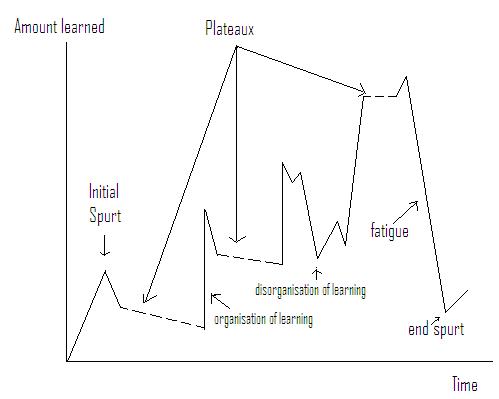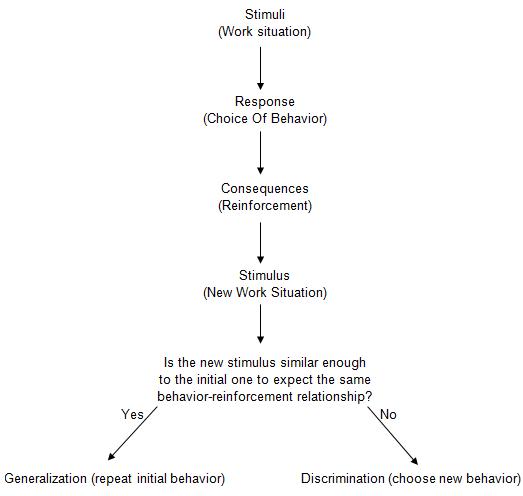A highly useful learning concept which is valid for a wide range of situation is the organizational learning curve, a diagrammatic presentation of the amount learned in relation to time. A typical learning curve will show on the Y-axis the amount learnt and the X-axis the passage of time. Characteristics of the Organizational Learning Curve Certain characteristics are common to all learning curves. One such feature is the initial spurt. At the beginning, it is natural that the rate of learning exhibits spurt. Usually, the graph levels off at some stage, indicating that maximum performance has been achieved. Apparently at the beginning of the learning process, the subject is highly motivated and seems to exhibit a significant surge of effort. Many experienced trainers exploit this initial spurt by selecting the most important items to be communicated and presenting them as a package to the students at the beginning of the Continue reading
Management Concepts
Stimulus Generalization and Stimulus Discrimination in Organizations
Stimulus Generalization in Organizations Stimulus generalization refers to how people recognize the same or similar stimuli in different settings. In other words, it is the process by which they can generalize a contingent reinforcement from one setting to another. Consider the plant manager of a manufacturing company who has a history of effective troubleshooting. Over the years he has been assigned to several plants, each with a serious operating problem. After successfully dealing with the difficulties, he has always received an extended vacation, a bonus and an increase in his base salary. He has learned the basic contingencies or requirements of reinforcement for his job. The stimulus is the assignment, the response is correcting problems and the consequences are several positive reinforcers. When the manager gets his next assignment, he will probably generalize from his past experiences even though he will be in a different plant with different problems and Continue reading
Perception in Organizations
Perception in Organizational Behavior Perception is an important mediating cognitive process. Through this complex process, people make interpretations of the stimulus or situation they are faced with. Both selectivity and organization go into perceptual, interpretations. Externally, selectivity is affected by intensity, size, contrast, repetition, motion and novelty and familiarity. Internally, perceptual selectivity is influenced by the individual’s motivation, learning and personality. After the selective process filters the stimulus situation, the incoming information is organized into a meaningful whole. Individual differences and uniqueness are largely the result of the cognitive processes. Although there are a number of cognitive processes, it is generally recognized that the perceptual process is a very important one. It is a process that takes place between the situation and the behavior and is most relevant to the study of organizational behavior. For example, the observation that a department head and a subordinate may react quite differently to Continue reading
Ten Personality Factors in Organizational Behavior
Personality is a complex, multi-dimensional construct and there is no simple definition of what personality is. Salvatore R. Maddi defines personality as, “A stable set of characteristics and tendencies that determine those commonalities and differences in the psychological behavior and that may not be easily understood as the sole result of the social and biological pressures of the moment”. All individuals have some universally common characteristics. Yet they differ in some other specific attributes. This makes it difficult for the managers to assume that they can apply same reward types or motivation techniques to modify different individual behaviors. The definition, however, does not mean that people never change. In simple terms, it asserts that individuals do not change all at once. Their thoughts, feelings, values and actions remain relatively stable over time. Changes in individual’s personality can, however, occur gradually over a period of time. The managers should, therefore, attempt Continue reading
Goal-Setting Theory of Motivation
This approach to motivation has been pioneered in the USA by Edwin Locke and his associates in 1960s and refined in 1980s. Goal-setting theory of motivation suggests that managers and subordinates should set goals for an individual on a regular basis, as suggested by Management by Objectives (MBO). These goals should be moderately difficult and very specific and of type that an employee will accept and make a commitment to accomplishing them. Rewards should be tied directly to accomplished goals. When involved in goal-settings, employees see how their effort will lead to performance, rewards and personal satisfaction. Salient features of Goal-setting theory of motivation are as follows: Specific goal fixes the needs of resources and efforts. It increases performance. Difficult goals result higher performance than easy job. Better feedback of results leads to better performances than lack of feedback. Participation of employees in goal has mixed result. Participation of Continue reading
Leadership Theories
Leadership is an integral part of management and plays a vital role in managerial operations. Leadership provides direction, guidance, and confidence to the employees and helps in the attainment of goals in much easier way. In business and industrial organizations, managers play the role of leader and acquire leadership of subordinates, their efforts towards the achievement of organizational goals and activate the individuals of an organization to make them work. Leadership influences behavior of the individuals. It has an ability to attract others and potential to make them follow the instructions. Individuals can be induced to contribute their optimum towards the attainment of organizational goals through effective leadership. Leadership acquires dominance and the followers accept the directives and control of a leader. Leadership provides direction and vision for future to an organization. A number of theories and approaches to study leadership have been developed. There are broadly three leadership theories Continue reading





